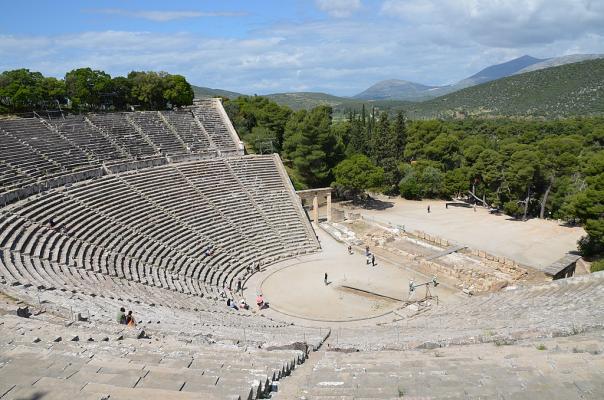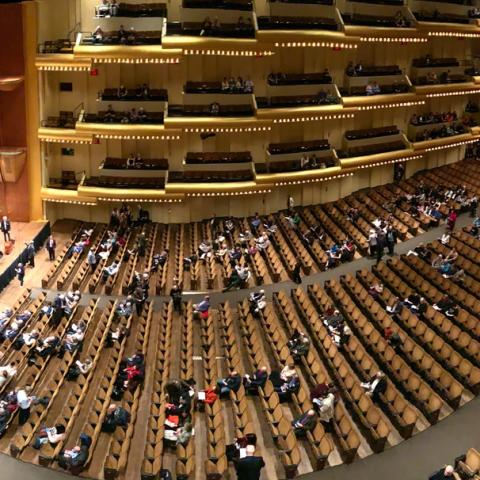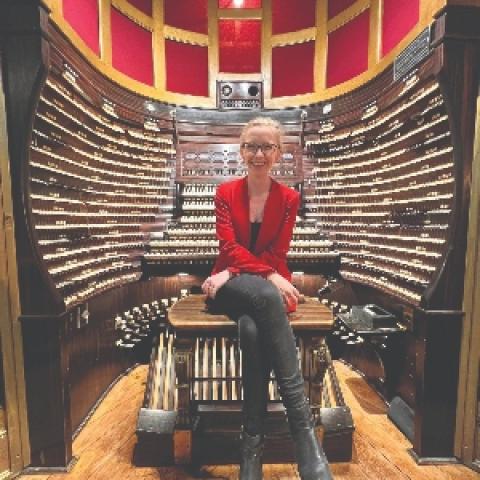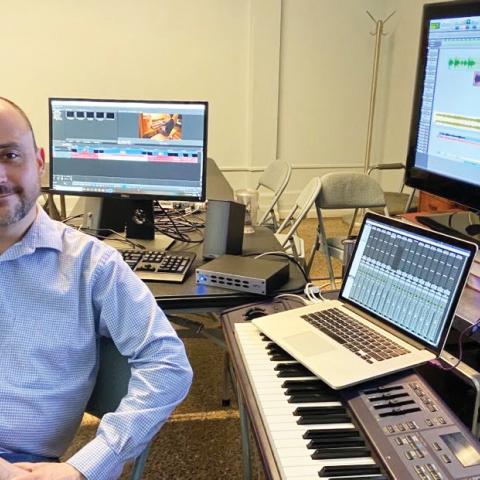
Photo caption: The amphitheater at Epidaurus (photo credit: Carole Raddato, used through the Creative Commons Attribution-Share Alike 2.0 Generic license)
A break in the action
Last night, my wife Wendy and I watched the American Masters documentary, “Where Now Is,” about Michael Tilson Thomas, widely known as MTT, who recently retired as music director of the San Francisco Symphony. His tenure in San Francisco spanned nearly twenty-five years during which the orchestra grew in stature and popularity. I admire how a brilliant conductor can build an orchestra over time, nurturing the musicianship of the individual players and the strength of the ensemble. I consider the symphony orchestra to be one of the greatest achievements of human culture. It amazes me that all those musicians, each an accomplished soloist with the requisite ego, can come together on a hundred-foot stage and perform with such precision of ensemble.
MTT had a dramatic conducting debut at a very young age. On October 22, 1969, William Steinberg was conducting a concert by the Boston Symphony Orchestra at Carnegie Hall, opening the program with Brahms’s Second Symphony during which he fell ill. At the end of the piece, Steinberg left the stage, found MTT, assistant conductor of the BSO, said something like, “Put on a suit. You’re going to conduct,” and was taken to Roosevelt Hospital.
The following morning, Harold Schoenberg of The New York Times reported, “Young Mr. Thomas, 24 years old, had his golden opportunity and made the most of it. He conducted Robert Starer’s Concerto for Violin, Cello, and Orchestra, and Strauss’s Till Eulenspiegel with an air of immense confidence and authority and showed that his confidence was not misplaced.” (Leonard Bernstein had a similar sudden debut. He was twenty-five when he filled in for the ailing Bruno Walter at the last minute, conducting the New York Philharmonic Orchestra.)
MTT’s precocious brilliance kick-started his storied career as music director of the Buffalo Philharmonic Orchestra, principal guest conductor of the Los Angeles Philharmonic, and principal conductor of the London Philharmonic before going to San Francisco. Perhaps his crowning achievement is the creation of the New World Symphony in Miami Beach, Florida. Founded in 1987, the New World Symphony is an orchestral academy whose mission statement is “to prepare highly gifted graduates of distinguished music programs for leadership roles in ensembles and orchestras around the world.”
I was especially moved to watch MTT in private coaching sessions with the young musicians of the New World Symphony, as well as his rehearsal techniques with the full orchestra. Wendy and I commented to each other that he was always smiling. Of course, the editor of the film may have had some control over that, moments of ill temper left on the cutting room floor, but I don’t think so.
Frank Gehry was the principal architect for the spectacular New World Center, home of the New World Symphony, opened in Miami Beach in 2011. Hilariously, it was noted that Gehry was MTT’s babysitter when both were growing up in Los Angeles.
Watching that film was bittersweet. It has been more than a year since we sat in a concert hall to hear an orchestra perform. The last live performance Wendy and I saw together was a disappointing new opera, four days before she left the city for our exile in Maine. (I followed her four days later.) MTT’s enthusiasm and that of the many colleagues we saw in orchestras and in separate interviews was infectious and a poignant reminder of all that we have lost in the last year. As I remember our life in the city, I think of the many thrilling plays, musicals, and concerts we have seen. I think of the stagehands, ushers, electricians, carpenters, costume designers, and actors whose livelihood vanished overnight. A quick look at my calendar shows that I had dinner with a colleague in a posh restaurant in lower Manhattan on Thursday, March 12, 2020, the same day that forty-two Broadway theaters, countless off-Broadway venues, Carnegie Hall, the Metropolitan Museum of Art, the Metropolitan Opera, the New York Philharmonic, and many other cultural venues closed. It first seemed that those places would reopen in a few weeks, but that was not to be.
Weathering the storm
In the December 2015 issue of The Diapason, I wrote of our first visit with our grandson Samuel, four days after his birth. In that essay, I wondered what life would bring him, I looked forward to being able to share cultural experiences with him and his older brother Benjamin, and I wondered what their educations would be like. I remembered the goitered and aptly named Mrs. Louden who taught music in the public schools when I was a kid, making twice-a-week visits to each classroom, braying simple songs. She drew staves on the blackboard with that cool five-gang chalk holder and taught us musical notation. “Every good boy deserves fudge,” but come to think of it, I do not remember what the girls got. I don’t think that is going to happen for them in public school.
As I thought about that precious young life, I could not have imagined that he’d spend his fifth birthday on lockdown, or that Chris would take leave from his job as a high school teacher, develop a curriculum for approval by the school principal, and home-school his sons so they would not have to spend all of Covid-tide glued to screens. I could not have imagined that they would have to be isolated from their friends, many of whom they can see from the windows of their condominium apartment or learn to wear masks whenever they leave their home.
I wonder what it will be like for them when the coast is clear and they can re-socialize. Will they experience growing pains as they reconnect with their pals? Will it be hard for them to return to classroom learning? We all wonder together what the “new normal” will be, even as we look forward to returning to a former life.
Rusty
On February 3, 2021, Gregory Wallace and Pete Muntean reported on CNN that airline pilots who had been idled by reduced air travel during the pandemic are finding that they are rusty when they return to the air and making errors managing their aircraft. Early in their article they wrote, “‘This was my first flight in nearly three months,’ one pilot wrote in a June report explaining why he or she neglected to turn on the critical anti-icing system. ‘I placed too much confidence in assuming it would all come back to me as second nature.’” A few paragraphs down, there was a bold heading, “Boy, was I wrong!”
Watching MTT lead rehearsals had me wondering what it will take to rebuild musical ensembles when the spread of the virus is contained. A symphony orchestra becomes great because its members play together all the time. They are in rehearsal and concerts five or six days a week, and they learn the musical intuitions as well as the quirks and habits of their fellow musicians. A violinist might think to herself, “He’s going to flub that note at the page-turn,” and compensate subconsciously. A second clarinet is inspired by the principal to stretch that phrase just a touch. How much rejuvenation will it take to rebuild the intimate ensemble, that greatest of collegial achievements? Musicians often refer to a sloppy performance as a “train wreck.” I hope “plane crash” does not become part of that lexicon.
Will a rusty theater electrician fail to tighten a bolt allowing a light to fall during a play?1 Will actors and dancers step on each other’s toes? Will they have crises of confidence? Performance is a tricky thing that blends pedagogy, intuition, memory, expression, and confidence. Remember Harold Schoenberg writing that MTT conducted with “an air of immense confidence and authority and showed that his confidence was not misplaced.” I love that his confidence was not misplaced. Any performer knows exactly what that means and so do astute listeners, as in, “He had no business being that sure of himself.” I know I have played concerts during which my confidence was misplaced.
§
Human creativity reached a zenith in the last centuries before the birth of Christ. The marvelous architecture of ancient Rome and Greece, the literature of Sophocles and Euripides, and the mathematical understanding of Archimedes and Euclid all bear witness to the genius of that age. And don’t forget my hero Pythagoras (570 BC–495 BC) who discovered the musical overtone series, defined musical intervals, and developed systems of tuning.
The Sacred Triangle of Greece comprises the Temple of Apollo at Delphi, the Temple of Athena Parthenos (the Parthenon) in Athens, and the Temple of Athena Aphaia on the island of Aegina. The three sites were built within a few years of each other around 500 BC and form a perfect isosceles triangle, a hundred miles on each side. How did they plot that triangle when one leg crosses mountains and the other two cross bodies of water? Celestial navigation was first practiced by the Phoenecians around 2000 BC, and in the second century BC, Hipparchus, a Greek astronomer, developed the concept of longitude, assuming a spherical earth and dividing it into 360 degrees.
Several years ago, visiting our daughter’s in-laws in Athens, Greece, her father-in-law Christos, an architect, took us to visit the Sanctuary of Asklepios, the god of medicine, at Epidaurus, about ninety miles from Athens. We have probably visited a dozen Greek amphitheaters, but the one at Epidaurus, built in the fourth century BC and seating 14,000, takes the cake. The immense structure is a section of a perfect sphere that produces whispering acoustics in a vast space and has remained perfectly level for over two thousand years. How did they do that without a laser-level? How did they know the ground would be that stable for millennia? How did they plot that perfect sphere?
Christos told how he worked for a large architectural firm that held retreats at that site, when the head of the firm posed the rhetorical question, “Who was the bastard who burned the library at Alexandria?” That library was a depository of human knowledge recorded in hundreds of thousands of scrolls, estimated to be the equivalent of 100,000 books. Its destruction was part of the decline of intellectual activity that led to the Dark Ages, which ran roughly from 700 AD until the thirteenth century. It was a time of ignorance and war, and as populations increased faster than medical care developed, the era was rife with disease and pandemics such as the Black Death.
Humankind broke out of the Dark Ages into a time of explosive creativity. In the world of music, we remember the remarkable pipe organ in Sion, Switzerland (approximately 1390), Guillame DuFay (1397–1474), Johannes Ockeghem (died 1497), and Josquin des Prez (died 1521). Leonardo da Vinci (1452–1519) had a lot to say in the arts and sciences, Titian (1490–1576) and Michelangelo (1475–1564) brought the visual arts to dizzying heights.
§
Our year of pandemic is a hiccup compared to the Dark Ages, but just as the Renaissance bloomed out of despair, I think we are going to see an explosion of creativity when orchestras can return to the stage and rehearsal room, when theaters can open and host dramatic expression, when museums can welcome in crowds hungry to learn, and when we can gather with friends before or after a concert to revel in the thrill of creativity and the thrall of our lasting companionship.
While Facebook is full of flaws and has certainly made it easy for people to stir up trouble, I have loved witnessing the “creativity in exile” of many friends and colleagues. People have been sharing their Covid-tide projects, learning new literature, writing new music, finding ways to create ensembles online, all to keep the arts alive. I have seen performances of Bach cantatas on Zoom that project the intimacy of musical relationships and love of the music. If those great pieces can be brought alive remotely, I cannot wait to hear how musicians interact when they can gather in person again.
I have been thinking especially about church choirs. In my days as a church musician, choir night was a highlight of the week. Thinking of my own workload and availability of volunteer time, I appreciated the ability of people to carve out that time. Many of the members of choirs I led had young children, so their participation depended on the willingness of a spouse to be at home making supper, supervising homework, and making sure the kids got cleaned up and to bed on time. And each Thursday evening, as many as a dozen choir members came to our house for BYOB after rehearsal, singing around the piano, ordering pizza, building a loving social group as part of their volunteer service to their church.
Those deep and lasting friendships had everything to do with the quality of their music making. Chatting about the music over drinks after a rehearsal is a big part of ensemble building, as are shared visions, shared life experiences, shared opinions, and shared jokes. A choir that can laugh together sings better together. I remember an evening when we were working on a particularly difficult passage in William Byrd’s five-part (with two tenors) setting of Ave, Maria, when in frustration, one of the tenors burst out with “Oy vey, Maria,” and the choir fell into the kind of unstoppable laughter that makes your eyes water and your belly hurt. It took a few more readings of the piece before we could pass that measure without cracking up, but the performance was the richer for it.
Tens of thousands of devoted choir members are missing all that these days. I encourage those of you who lead choirs to be nurturing your groups, maintaining those social and musical relationships in any way possible, and helping the volunteers to look forward to returning to the marvelous work of making music for the church. Won’t it be great to see the vested choir waiting at the back of the church as you start that processional hymn with a room full of people?
It’s not a train.
There’s a glimmer at the end of the tunnel. Vaccines are spreading across the globe, and they are proving to be effective. While most large cultural institutions are still closed or operating with significantly reduced schedules and capacities, there is a sense that we may be over the hump. I know I am eager to get back on the road and resume my former pattern of visiting the organs that I am dealing with. As I correspond with so many of you, I am longing for the time when I can call and say, “I’ll be in town next week, can we meet?” And I am looking forward to witnessing the celebrations as orchestras get back to work and our beloved church choirs can be free to have their fun. Be sure you’re ready, and when the time comes, give it all you’ve got.
Notes
1. I was once sitting in a concert hall with my first wife, waiting for a friend’s voice recital to start, when a heavy stage light crashed in front of the piano, right where the singer would have stood. The falling light was enough to cancel the concert. This was when my children were young, and we got home far earlier than expected to find the babysitter on the couch making out with her boyfriend. “Hi, this is Jimmie.”






